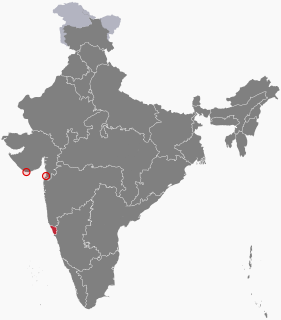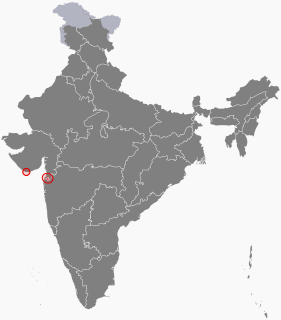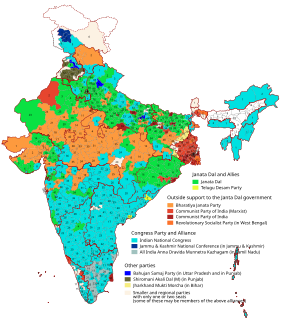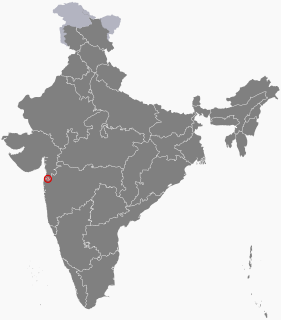
Daman and Diu was a former union territory in northwestern India. With an area of 112 km2 (43 sq mi), it was the smallest administrative subdivision of India on the mainland. The territory comprised two districts, Damaon and Dio island, geographically separated by the Gulf of Khambat. The state of Gujarat and the Arabian Sea bordered the territory. A Portuguese colony since the 1500s, the territories were taken by India with the Annexation of Goa in 1961. Daman and Diu were administered as part of the union territory of Goa, Daman and Diu between 1961 and 1987, after the Goa Opinion Poll they became a separate union territory. In 2019, legislation was passed to merge the union territory of Daman and Diu with its neighbouring union territory, Dadra and Nagar Haveli, to form the new union territory of Dadra and Nagar Haveli and Daman and Diu with effect from 26 January 2020.

Shashikala Kakodkar, popularly known as Tai, was a prominent leader of the Maharashtrawadi Gomantak Party (MGP). She served as the Chief Minister of Goa, Daman and Diu on two occasions, and also was the President of the Maharashtrawadi Gomantak Party. She is the first woman to serve as the Chief Minister of Goa, Daman and Diu.

Goa, Daman and Diu was a union territory of the Republic of India established in 1961 following the annexation of Portuguese India, with Maj Gen K P Candeth as its first Military Governor. The Goa portion of the territory was granted full statehood within the Indian union on 30 May 1987, Daman and Diu remained a separate territory until December 2019, when it was merged with Dadra and Nagar Haveli and is today the territory of Dadra and Nagar Haveli and Daman and Diu.

Daman and Diu Lok Sabha constituency is one of the two Lok Sabha constituencies in the union territory of Dadra and Nagar Haveli and Daman and Diu in western India. This constituency came into existence in 1987, following the implementation of the Goa, Daman, and Diu Reorganisation Act, 1987.
Since independence, the Indian National Congress has participated in elections, Lok Sabha and Vidhan Sabha. This article shows a list of the results of the elections for Congress.
Dayanand Balkrishna Bandodkar and popularly known as Bhausaheb Bandodkar was the first Chief Minister of Goa, in the territory of Goa, Damaon& Diu. Born in Pernem to a Marathi family who had immigrated from Tuljapur, he became a wealthy mine owner following the Annexation of Goa. He sought to merge the territory with the state of Maharashtra. He swept the polls in 1963, 1967 and in 1972 while representing the Maharashtrawadi Gomantak Party (MGP) and remained in power until his death in 1973.

General elections were held in India between 19 and 25 February 1962 to elect members of the 3rd Lok Sabha. Unlike the previous two elections, each constituency elected a single member.

General elections were held in India on 22 and 26 November 1989 to elect the members of the 9th Lok Sabha. The incumbent Indian National Congress government under the premiership of Rajiv Gandhi lost its mandate, even though it was still the largest single party in the Lok Sabha. V. P. Singh, the leader of the second largest party Janata Dal was invited by the President of India to form the government. The government was formed with outside support from the Bharatiya Janata Party and a Left Front led by CPI (M). V. P. Singh was sworn in as the seventh Prime Minister of India on 2 December 1989.

Dadra and Nagar Haveli Lok Sabha constituency is one of the two Lok Sabha constituencies in the union territory of Dadra and Nagar Haveli and Daman and Diu. This constituency is reserved for the Scheduled Tribes.
The United Goans Party is a political party in state of Goa. It was formed in 1963 in the former union territory of Goa, Daman and Diu, with Jack de Sequeira as its party leader, when multiple regional parties merged during the Konkani language agitation.
Lalubhai Babubhai Patel is an Indian politician, belonging to Bharatiya Janata Party. He was elected to the Lok Sabha, the lower house of the Parliament of India as a member of the Lok Sabha in the 2009 election and reelected in the 2014 election and 2019 election from the Daman and Diu constituency.

The Tenth Amendment of the Constitution of India, officially known as The Constitution Act, 1961, incorporated Dadra and Nagar Haveli as the seventh Union territory of India, by amending the First Schedule to the Constitution. It also amended clause (1) of article 240 of the Constitution to include therein the Union territory of Dadra and Nagar Haveli in order to enable the President to "make regulations for the peace, progress and good government of the territory". The 10th Amendment retroactively came into effect on 11 August 1961.

The Twelfth Amendment of the Constitution of India, officially known as The Constitution Act, 1962, incorporated Goa, Daman and Diu as the eighth Union territory of India, by amending the First Schedule to the Constitution. India acquired control of Goa, Daman and Diu from Portugal in December 1961. The amendment also amended clause (1) of article 240 of the Constitution to include therein these territories in order to enable the President to "make regulations for the peace, progress and good government of the territory".

The Fourteenth Amendment of the Constitution of India, officially known as The Constitution Act, 1962, incorporated Pondicherry as the ninth Union territory of India, and also gave Parliament the authority to create by law, Legislatures and Councils of Ministers for the Union territories of Himachal Pradesh, Manipur, Tripura, Goa, Daman and Diu and Puducherry.
Gopal Kalan Tandel is an Indian politician. He was a Member of Parliament in the 8th and 1996-1998 in 11th Lok Sabha. He was the first parliamentarian to represent Daman and Diu in the Lok Sabha. He has been part of Indian National Congress, Bharatiya Janata Party, and currently Nationalist Congress Party.
Narayan Srinivasa Fugro was an Indian politician. He served as the Speaker of the Legislative Assembly of Goa, Daman and Diu between February 24, 1972 and January 20, 1980.
The Portuguese ruled territories of Goa, Daman and Diu were invaded and successfully annexed through Operation Vijay into the Republic of India on 19 December 1961. Since then, elections in the state are conducted in accordance with the Constitution of India to elect representatives of various bodies on national, state and district levels.

Dadra and Nagar Haveli and Daman and Diu is a union territory in India. The territory was constituted through the merger of the former territories of Dadra and Nagar Haveli and Daman and Diu. Plans for the proposed merger were announced by the Government of India in July 2019; the necessary legislation was passed in the Parliament of India in December 2019 and came into effect on 26 January 2020. The territory is made up of four separate geographical entities: Dadra, Nagar Haveli, Daman, and the island of Diu. All four areas were part of Portuguese Goa and Damaon with the former joint capital in Panjim, they came under Indian rule in the mid-20th century after the Annexation of Goa. These were jointly administered as Goa, Daman and Diu until 1987, when Goa was granted statehood after the Konkani language agitation. The current capital city is Daman.

Elections to the Goa, Daman and Diu Legislative Assembly were held in December 1984, to elect members of the 60 constituencies in Goa, Daman and Diu, India. The Indian National Congress won the most seats as well as the popular vote, and Pratapsingh Rane was re-appointed as the Chief Minister of Goa, Daman and Diu.
The first elections to the Goa, Daman & Diu Legislative Assembly were held in December 1963, to elect members of the 30 constituencies, in the Union territory of Goa, Daman and Diu, India.








